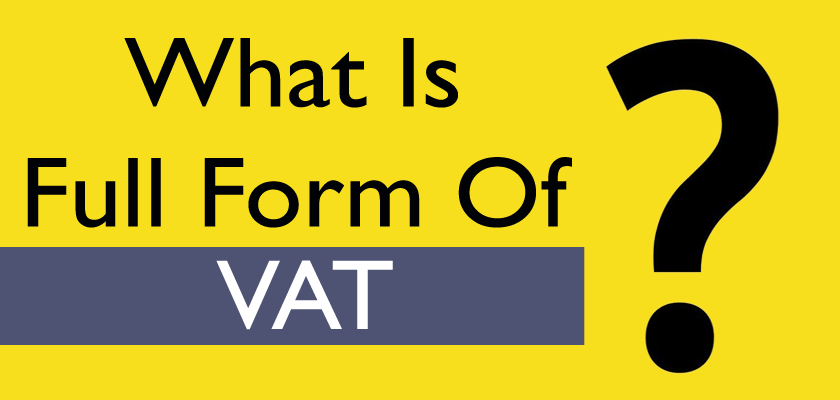Do you know what is the VAT Full Form? Value-added tax, more commonly known as VAT, is a tax levied on goods and services at each stage of production, sale, or distribution. It is a tax that is collected by businesses and ultimately paid by the end consumer. In this article, we will explore the full form of VAT, the history behind it, the different types of VAT, VAT rates, how to calculate VAT computation, and the advantages of the VAT system.
Table of Contents
What is the VAT Full Form?
The full form of VAT is Value-Added Tax. It is an indirect tax levied on the value added to goods and services at each stage of production and distribution. In 1954 this tax system was first introduced in France and has since been adopted by many countries around the world.
Introduction to VAT
VAT is a consumption tax applied to the final value added to a product or service. It is a tax that is collected by the businesses from the end customer and then sent to the government.
VAT is a broad-based tax that applies to the value of both goods and services. Its main objective is to replace the previous sales tax system with a system that is both more equitable and more effective.
The collected money from the taxes is used to employ the government policies such as funding new schemes the government, developing health services, helping economically backward people, improving the country’s infrastructure, providing social security, rural development, and paying national debt interest.
History of VAT System
The VAT system was first introduced in France and german during world war I years, and since then, many countries have adopted this tax system. The modern version of VAT was implemented independently by a German manufacturer named Dr Wilhelm Von Siemens in the early 20th Century.
In Europe, the adoption of VAT began in the 1960s, and it has since become the most common form of taxation in the European Union. The VAT system was adopted as a replacement for the sales tax system, which was seen as regressive, as it taxed all goods and services at the same rate, regardless of their value.
Types of VAT Calculation
There are two types of VAT Calculation:
The credit-invoice system 2. The subtraction-method system.
- Credit-invoice system– In the credit-invoice system, businesses collect VAT on sales and deduct the VAT paid on purchases. The difference is the amount of VAT that is owed to the government.
- VAT payable= Tax on sales Bill – Tax on purchase bill
- Subtraction-method system– The subtraction-method system, also known as the direct tax method, is used in some countries such as Japan and Australia. In this system, businesses are required to pay VAT on the value they add to goods and services.
- Taxable Turnover= Sales excluding taxes-purchase excluding taxes
- VAT Payable = Taxable turnover* tax rate
How to Calculate VAT Computation
VAT calculation is an easy process. To do this, multiply the value of the goods or services by the applicable VAT rate. For instance, if the value of the goods is $100 and the VAT rate is 20%, the VAT due is $20. The final consumer would have to pay $120 in total.
Businesses must keep detailed records of all transactions involving VAT, including sales, purchases, and the amount of VAT paid and collected.
What are the VAT rates?
VAT rates depend on the country and the type of taxable goods and services.
Some countries have different rates of VAT, with higher rates of taxes applied to luxury goods and lower rates of taxes applied to essential goods such as food and medicine.
The standard rate of VAT in the European Union is around 21%, while in some countries it can be as high as 28%.
India VAT Tax Rates
The VAT tax collected by the Government of India varies between the range of 5% to 28%. On the basis of rates, it is divided into the following types:
| 28% | Higher tax rate |
| 18% | First standard rate of tax |
| 12% | Second standard rate |
| 5% | Lower VAT rate. |
| 0% | No VAT rate |
What are VAT Advantages?
The VAT system offers several advantages over other tax systems:
Efficient system -It is a more efficient system, as it is self-regulated and requires fewer government resources for enforcement.
Equitable system- It is a more equitable system, as it applies the value of goods and services rather than a flat rate, which means that high-value goods are taxed more than low-value goods.
Transparent system- It is more transparent, as businesses must keep detailed records of all transactions involving VAT. This makes it easier for governments to monitor and regulate the tax system and reduces the chances of fraud.

Other VAT Full Forms List
| Term | Full Form | Category |
| VAT | Value Added Tax | Rules |
| VAT | Vinyl Asbestos Tile | Accounts and Finance |
| VAT | Vestibular Autorotation Test | Medical |
| VAT | Vatomandry | Airport Code |
| VAT | Holy See (Vatican City State) | Country ISO Code |
| VAT | Variable Allocation Table | Computer Assembly Language |
| VAT | VATLUR | Indian Railway Station |
| VAT | Vibro-acoustic Test | Space Science |
| VAT | Visual Audio Tool | Softwares |
| VAT | Vans Audio Tool | Softwares |
| VAT | Value Added Tool | Softwares |
| VAT | Voice Application Technology | Technology |
| VAT | Value-added Tax | Income Tax |
FAQs- What is the full form of VAT?
Q.1. What is the VAT Full Form?
Ans. The full form of VAT stands for Value Added Tax.
Q.2. What is the vat full form in medical?
Ans. In Medical, the VAT stands for Vestibular Autorotation Test.
Q.3. What is the vat full form in Hindi?
Ans. In Hindi, the full form of VAT stands for मूल्य वर्धित कर.
Q.4. What is the vat full form on the computer?
Ans. In Computers, the VAT Full Form stands for Value Added Tax.
Thanks for reading What is the VAT Full Form? Bookmark our website Whatisfullform.com to know or read our collection of full forms.


